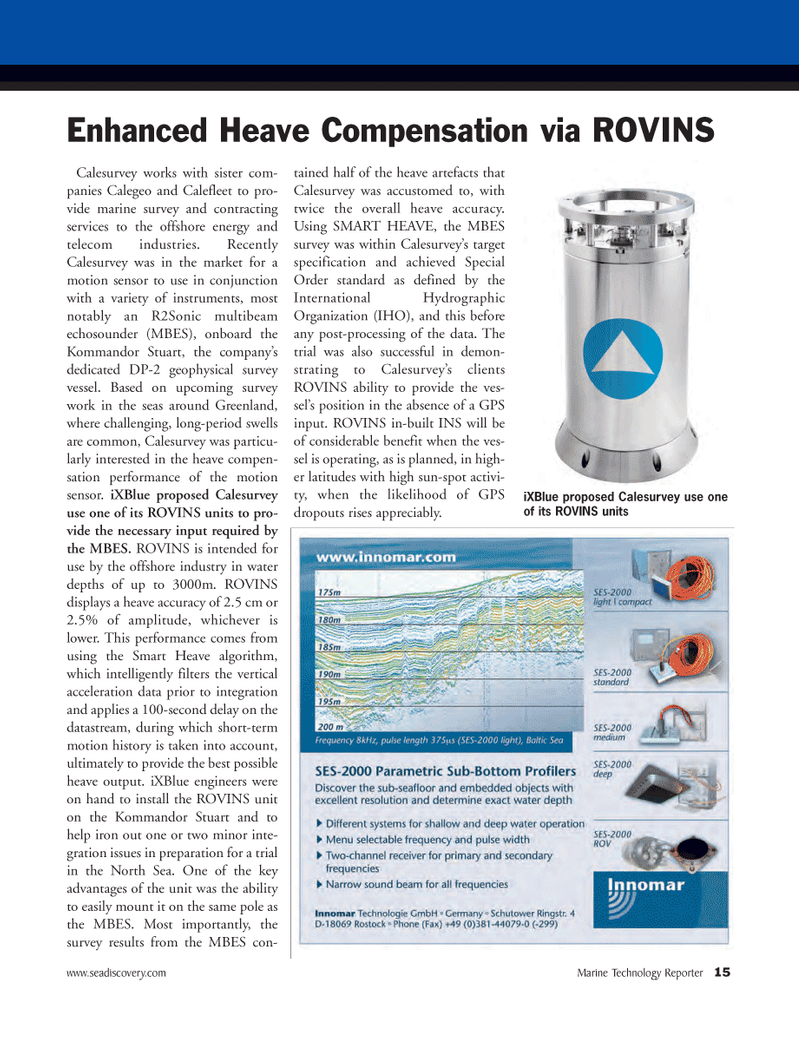
Page 15: of Marine Technology Magazine (November 2011)
FreshWater Monitoring and Sensors
Read this page in Pdf, Flash or Html5 edition of November 2011 Marine Technology Magazine
www.seadiscovery.com Marine Technology Reporter 15Calesurvey works with sister com- panies Calegeo and Calefleet to pro- vide marine survey and contracting services to the offshore energy and telecom industries. Recently Calesurvey was in the market for a motion sensor to use in conjunctionwith a variety of instruments, most notably an R2Sonic multibeam echosounder (MBES), onboard the Kommandor Stuart, the company?s dedicated DP-2 geophysical survey vessel. Based on upcoming survey work in the seas around Greenland, where challenging, long-period swells are common, Calesurvey was particu- larly interested in the heave compen- sation performance of the motion sensor. iXBlue proposed Calesurvey use one of its ROVINS units to pro- vide the necessary input required by the MBES.ROVINS is intended for use by the offshore industry in water depths of up to 3000m. ROVINS displays a heave accuracy of 2.5 cm or 2.5% of amplitude, whichever is lower. This performance comes from using the Smart Heave algorithm, which intelligently filters the vertical acceleration data prior to integrationand applies a 100-second delay on thedatastream, during which short-term motion history is taken into account, ultimately to provide the best possible heave output. iXBlue engineers were on hand to install the ROVINS unit on the Kommandor Stuart and to help iron out one or two minor inte- gration issues in preparation for a trial in the North Sea. One of the key advantages of the unit was the ability to easily mount it on the same pole asthe MBES. Most importantly, the survey results from the MBES con- tained half of the heave artefacts that Calesurvey was accustomed to, with twice the overall heave accuracy. Using SMART HEAVE, the MBES survey was within Calesurvey?s target specification and achieved Special Order standard as defined by the International Hydrographic Organization (IHO), and this before any post-processing of the data. The trial was also successful in demon-strating to Calesurvey?s clients ROVINS ability to provide the ves- sel?s position in the absence of a GPS input. ROVINS in-built INS will be of considerable benefit when the ves- sel is operating, as is planned, in high-er latitudes with high sun-spot activi-ty, when the likelihood of GPS dropouts rises appreciably. Enhanced Heave Compensation via ROVINSiXBlue proposed Calesurvey use one of its ROVINS units MTR#9 (1-17):MTR Layouts 11/29/2011 10:24 AM Page 15

 14
14

 16
16
